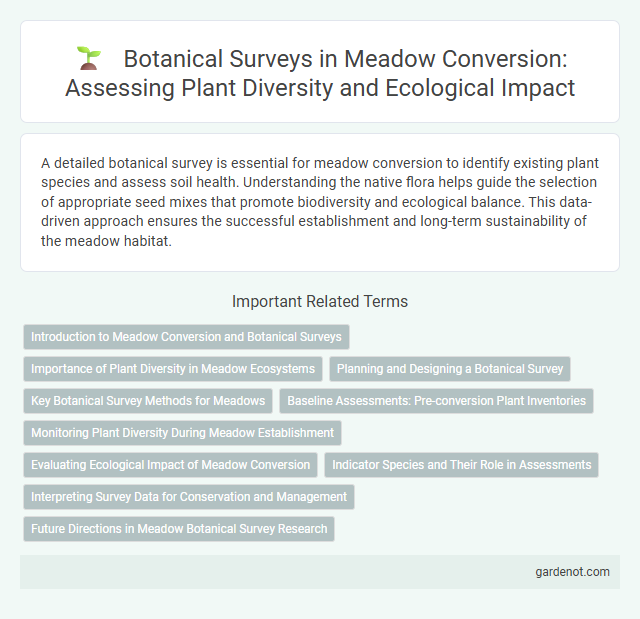A detailed botanical survey is essential for meadow conversion to identify existing plant species and assess soil health. Understanding the native flora helps guide the selection of appropriate seed mixes that promote biodiversity and ecological balance. This data-driven approach ensures the successful establishment and long-term sustainability of the meadow habitat.
Introduction to Meadow Conversion and Botanical Surveys
Meadow conversion involves transforming existing land into diverse, species-rich meadows that enhance ecological health and biodiversity. Botanical surveys play a crucial role in assessing current vegetation, identifying native species, and guiding the selection of appropriate plants for successful meadow establishment. Detailed surveys ensure that meadow conversion projects promote habitat restoration and support local wildlife effectively.
Importance of Plant Diversity in Meadow Ecosystems
Plant diversity in meadow ecosystems supports resilience against environmental stressors, enhances pollinator habitats, and promotes soil health. Botanical surveys identify key species that contribute to ecosystem functions, aiding in targeted conservation and restoration efforts. Maintaining a rich variety of native plants ensures sustained ecosystem services such as nutrient cycling and habitat provision for wildlife.
Planning and Designing a Botanical Survey
Planning and designing a botanical survey for meadow conversion requires detailed assessment of existing plant species, habitat types, and ecological conditions to establish baseline biodiversity data. Precise selection of survey methods, such as quadrat sampling and transect walks, ensures comprehensive coverage of meadow flora and supports data accuracy. Incorporating seasonal timing and geographic variability optimizes species detection and informs effective meadow restoration strategies.
Key Botanical Survey Methods for Meadows
Key botanical survey methods for meadows include quadrat sampling, transect walks, and species inventory, which help in accurately assessing plant diversity and abundance. Quadrat sampling involves placing a square frame to identify and count species within fixed plots, providing detailed data on vegetation density. Transect walks enable systematic observation across gradients, capturing variations in flora distribution essential for meadow ecosystem analysis.
Baseline Assessments: Pre-conversion Plant Inventories
Baseline assessments in meadow conversion projects involve comprehensive botanical surveys to document pre-conversion plant inventories, capturing species diversity, abundance, and distribution. Accurate identification of native and invasive species is crucial for monitoring ecological changes and informing restoration strategies. These surveys establish essential reference data that guides effective meadow habitat enhancement and long-term conservation planning.
Monitoring Plant Diversity During Meadow Establishment
Monitoring plant diversity during meadow establishment involves conducting systematic botanical surveys to track species composition, abundance, and growth stages. Detailed vegetation assessments utilize quadrats and transects to ensure native flora thrives while invasive species are identified and managed promptly. Continuous data collection supports adaptive management, enhancing biodiversity outcomes and ecosystem resilience in restored meadows.
Evaluating Ecological Impact of Meadow Conversion
Botanical surveys provide critical data on species composition and abundance before and after meadow conversion, enabling accurate assessment of ecological impacts. Evaluating shifts in plant diversity, presence of native versus invasive species, and changes in habitat quality helps determine the success of restoration efforts. Detailed vegetation monitoring guides adaptive management to promote biodiversity and ecosystem resilience in converted meadows.
Indicator Species and Their Role in Assessments
Indicator species such as oxeye daisy, cowslip, and meadow vetchling play a crucial role in botanical surveys by reflecting the ecological quality and biodiversity of meadows. Their presence and abundance provide essential data for assessing habitat condition, guiding restoration efforts, and ensuring successful meadow conversion. Monitoring these species helps to detect changes in soil health, nutrient levels, and overall ecosystem stability during and after conversion practices.
Interpreting Survey Data for Conservation and Management
Interpreting botanical survey data for meadow conversion involves analyzing species composition, abundance, and distribution to assess habitat quality and biodiversity value. Identifying indicator species and monitoring changes over time guide conservation priorities and adaptive management strategies. Detailed evaluation of soil conditions and microhabitats ensures tailored interventions that support native flora and promote ecological resilience.
Future Directions in Meadow Botanical Survey Research
Emerging technologies such as UAV remote sensing and AI-driven species identification are revolutionizing meadow botanical surveys, enabling more precise and large-scale vegetation mapping. Future research emphasizes integrating multi-temporal data to monitor phenological changes and ecosystem responses to climate change. Collaborative platforms combining citizen science with expert validation enhance data accuracy and broaden spatial coverage for meadow biodiversity assessments.
Botanical survey Infographic

 gardenot.com
gardenot.com